Earthquake Effect on Dam, CFD Simulation by ANSYS Fluent Tutorial
$240.00 $120.00 Student Discount
- The problem numerically simulates the effect of an earthquake on a dam using ANSYS Fluent software.
- We design the 3-D model by the Design Modeler software.
- We Mesh the model by ANSYS Meshing software, and the element number equals 812943.
- We perform this simulation as unsteady (Transient).
- We use the VOF Multi-Phase model to define water and air.
- We use the Frame Motion to define a movement in this model with a UDF.
To Order Your Project or benefit from a CFD consultation, contact our experts via email (info@mr-cfd.com), online support tab, or WhatsApp at +44 7443 197273.
There are some Free Products to check our service quality.
If you want the training video in another language instead of English, ask it via info@mr-cfd.com after you buy the product.
Description
Description
The present problem simulates the effect of an earthquake on a dam using ANSYS Fluent software. We perform this CFD project and investigate it by CFD analysis.
The present model is designed in two dimensions using Design Modeler software. The model includes a computational area that includes water and air flows, so a dam with an asymmetric geometric shape is designed in this area.
The meshing of the model has been done using ANSYS Meshing software. The element number is 812943.
Also, a transient solver was enabled due to the nature of the simulated phenomenon, which is time-progressing.
Earthquake Methodology
A computational area is designed around a dam with water and air currents to perform this simulation. Therefore, a multiphase model of VOF (volume of fluid) has been used to define two air and water flows; So its primary phase is air, and its second phase is water flow.
Since the interface boundary of the two air and water currents is recognizable and the two fluids do not mix, the multiphase VOF model is used. Using Region Production and the Patch tool, water flow can be separated from the initial airflow.
The Frame Motion technique defines the earthquake process, in which a UDF is used to determine the type of movement and displacement of the computational area.
The simulation is time-dependent to examine the pressure changes on the dam surface and the displacement of the water flow of the free surface over time. Also, the standard k-epsilon model is used to solve turbulent fluid equations.
Earthquake Conclusion
At the end of the solution process, three-dimensional contours related to the volume fraction of each water and air phase are obtained. Then, a three-dimensional image of the water flow’s free surface is obtained using the Iso-Surface tool and considering the volume fraction value of 0.5 for each phase.
According to the image obtained from the free surface of the water flow, it can be said that the water flow has been completely affected by the earthquake and has become entirely turbulent. The pressure, velocity, and kinetic energy counters of turbulence are obtained on this water’s free surface.
The study of changes in pressure and velocity on the water’s free surface also shows an earthquake’s effect.
These contours correspond to the last second of the simulation process or the final moment of the earthquake. Furthermore, two-dimensional contours of static pressure and wall tension on the ground surface and the dam’s surface have been obtained.
Also, a graph of changes in the mean static pressure on the dam’s surface over time is obtained.

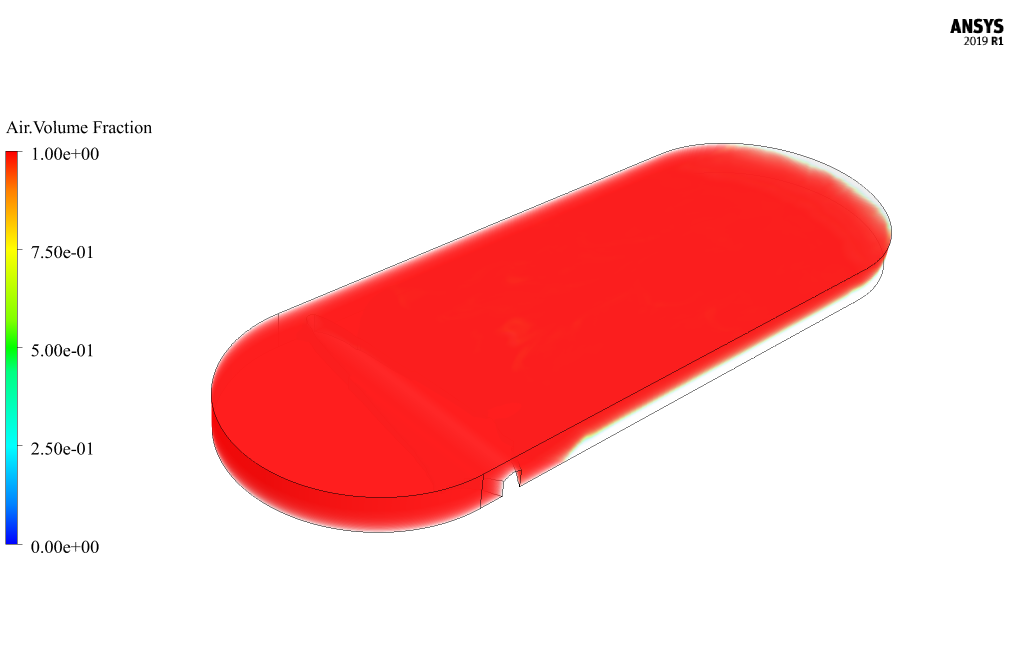
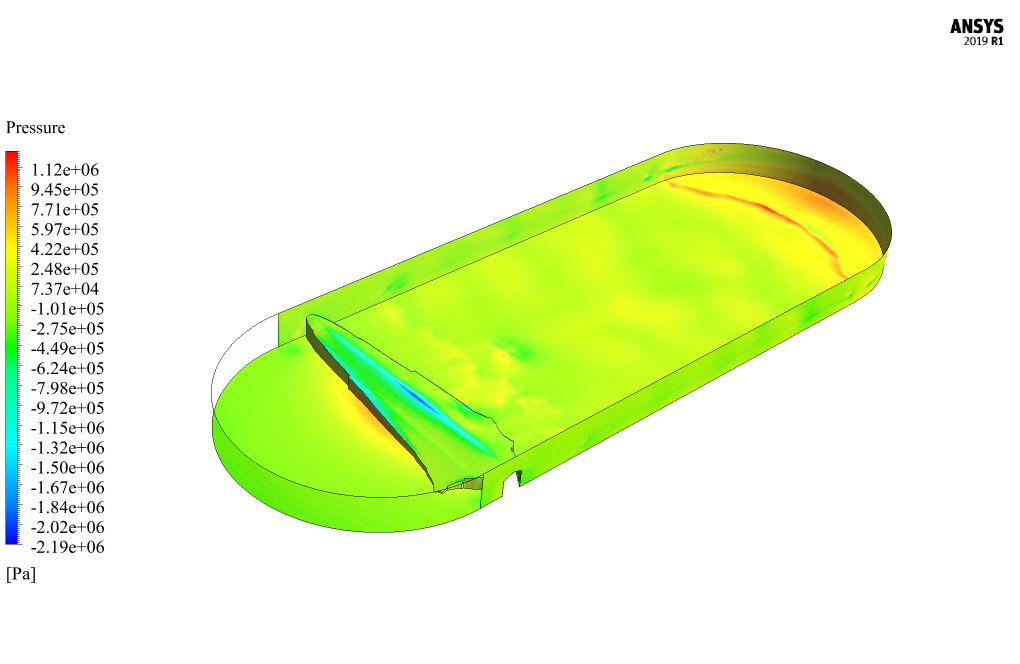
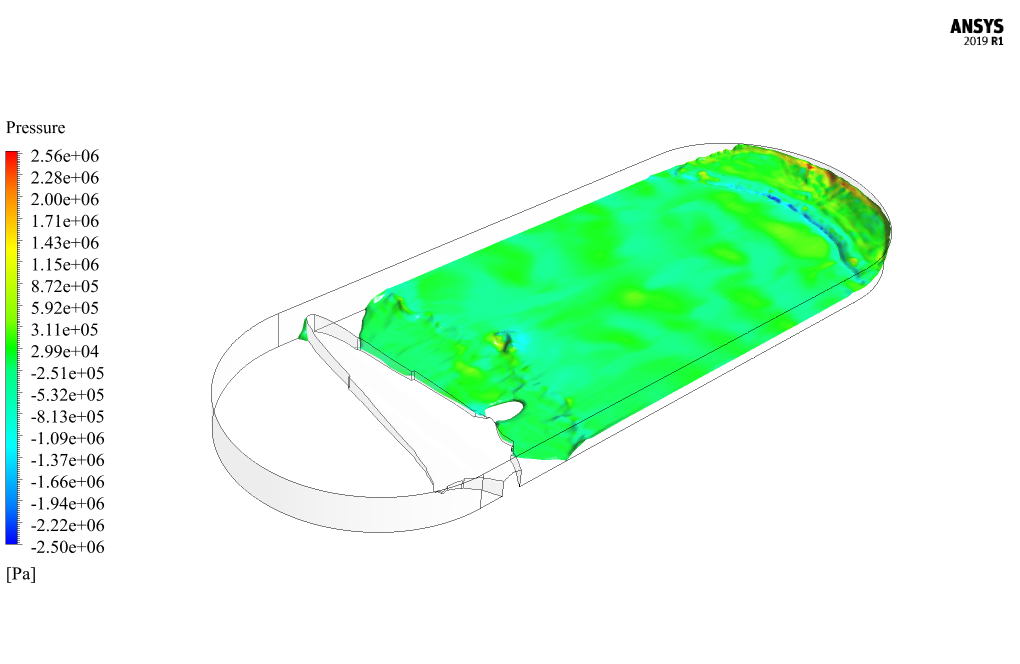
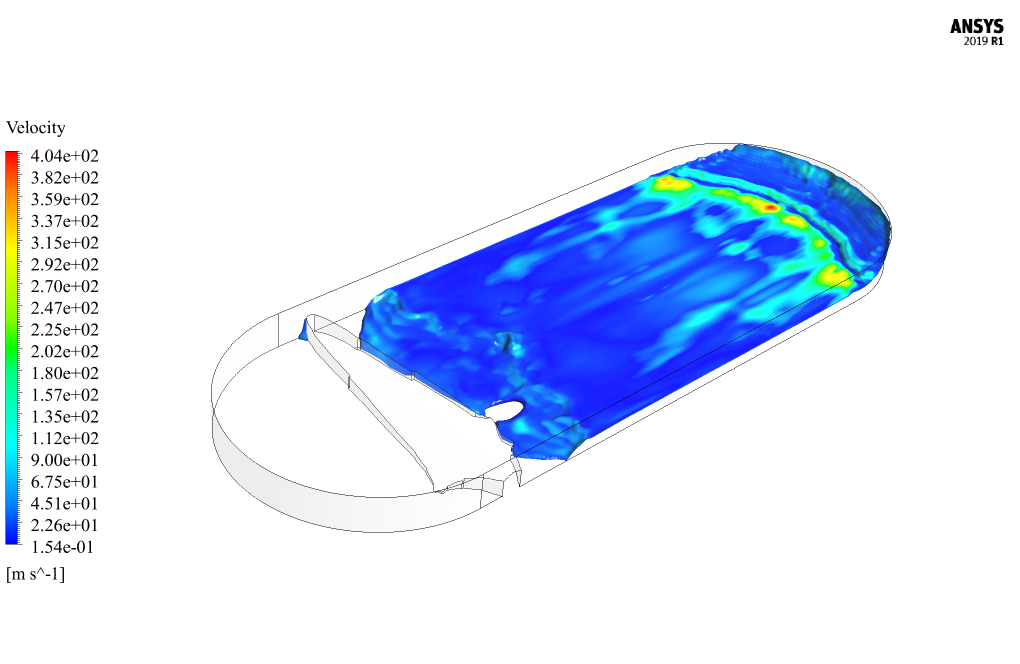
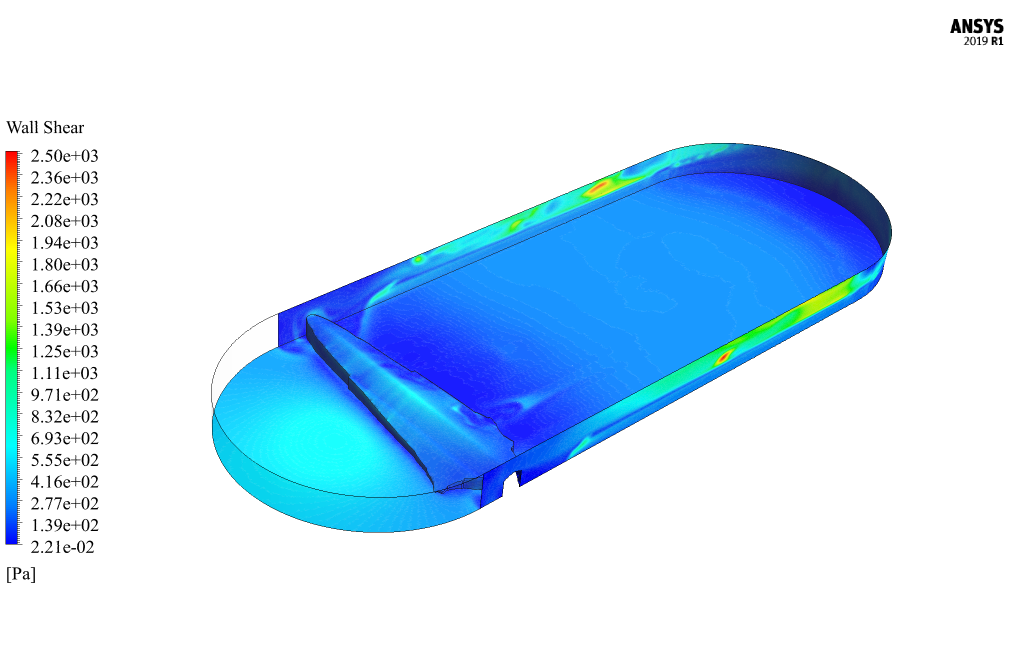
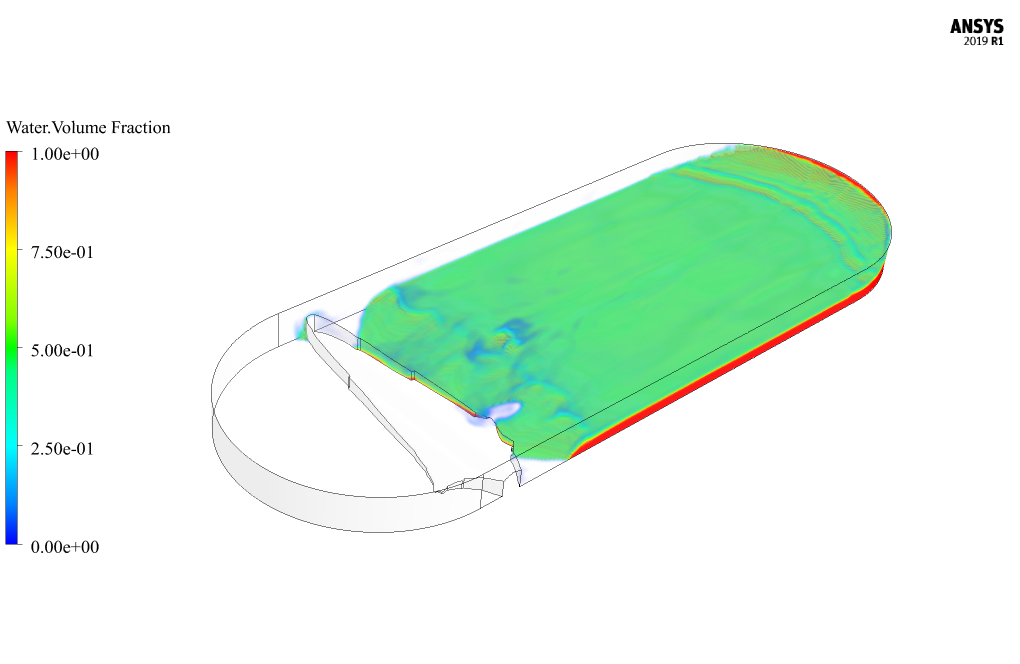
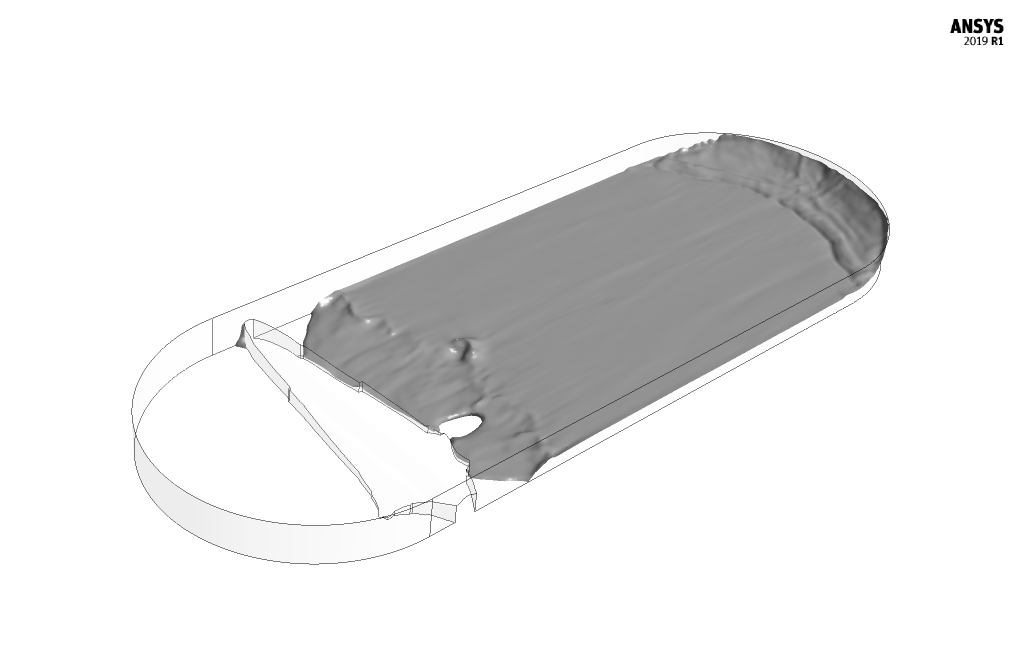

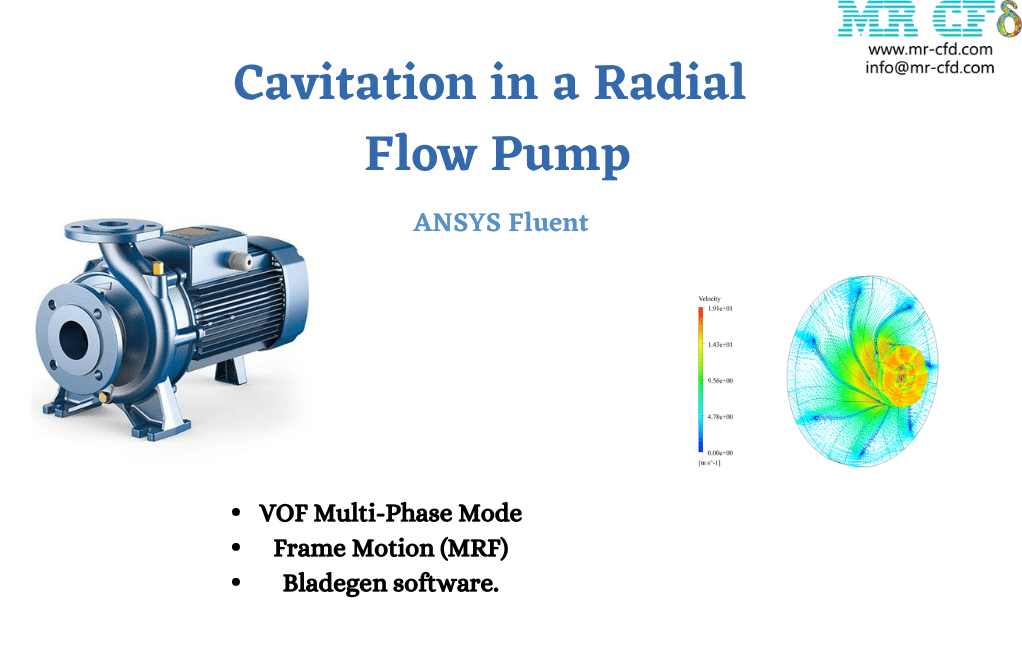
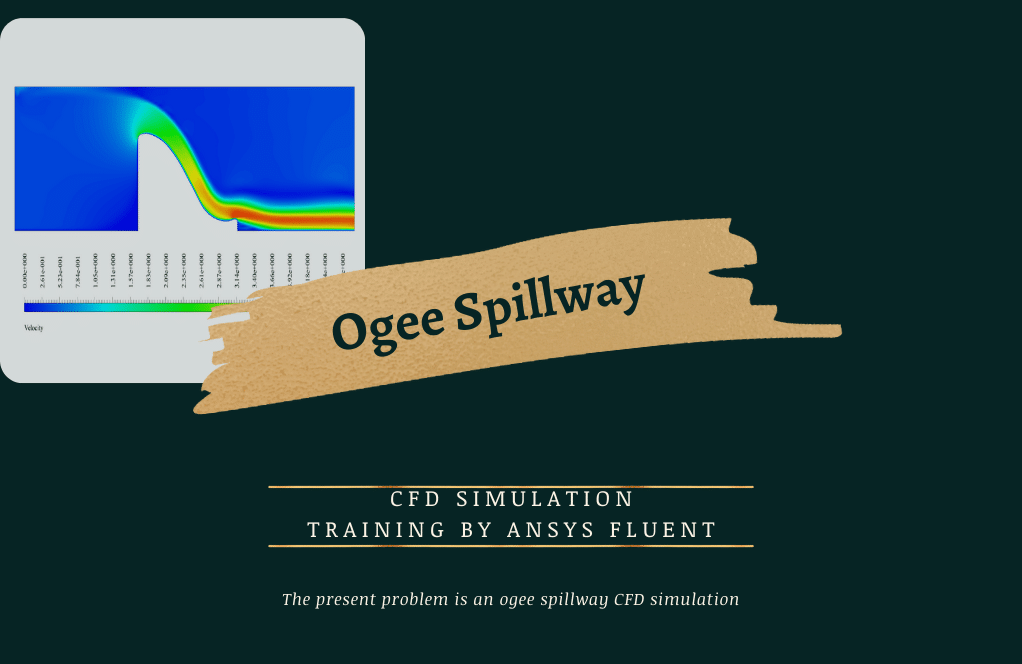
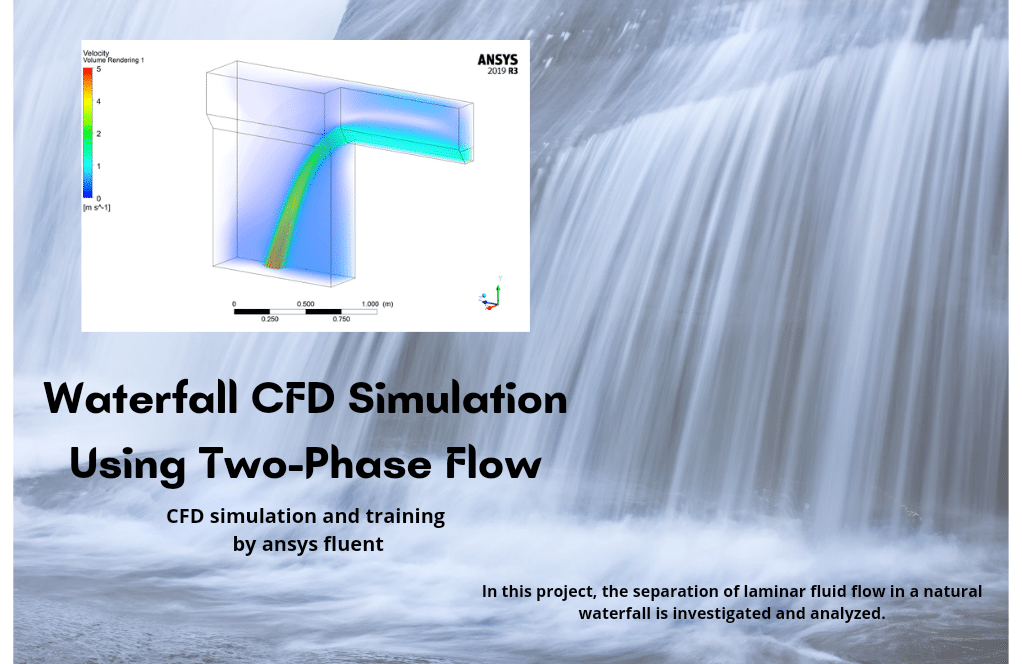

Talia Murray –
I have some ideas for improving this simulation. Can I contribute?
MR CFD Support –
We welcome and appreciate contributions. Your ideas could help us improve our simulations and provide better solutions to our users. Thank you for your interest and support!
Kaleigh Toy V –
I appreciate the dedication to accuracy and validation in this simulation.
Kaelyn Bruen –
How accurate is this simulation in predicting the behavior of a dam during an earthquake?
MR CFD Support –
The simulation uses advanced numerical methods and real-world earthquake data to provide a highly accurate prediction of a dam’s behavior during an earthquake. However, like all simulations, it should be used in conjunction with other engineering analyses and not as a sole decision-making tool.
Dallin Larkin –
Can this simulation handle different types of dams?
MR CFD Support –
Yes, the simulation can be adapted to handle different types of dams by changing the dam geometry and material properties in the simulation setup. This makes it a versatile tool for various applications.
Abagail Breitenberg –
Does the study take into account aftereffects such as potential structural weakening or cracks in the dam post-earthquake?
MR CFD Support –
The current simulation focuses on the immediate fluid dynamics effects of the earthquake, including pressure and velocity changes on the dam surface and turbulence in the water. It doesn’t explicitly account for structural weakening, fatigue or cracking that might occur in the actual dam post-earthquake. These would typically require additional structural analysis post the initial CFD simulation in a specialized structural engineering software.
Liliana Ferry –
How does this simulation model the effect of an earthquake on a dam?
MR CFD Support –
The simulation models the effect of an earthquake on a dam by applying a seismic load to the dam structure. This load is based on real-world earthquake data and is applied in a way that mimics the movement of the earth during an earthquake.
Loyal Glover –
What specific function does the UDF define within the Frame Motion techniquefor the earthquake simulation on the dam?
MR CFD Support –
The UDF (User-Defined Function) within the Frame Motion technique for earthquake simulation helps to define the profile of the ground motion during an earthquake, including displacement, velocity, and acceleration as functions of time. This allows for accurate replication of the movement that the dam would experience during an actual earthquake event.
Crawford Hill –
I was fascinated by the modeling of the earthquake’s effect on the dam. Could you please explain how the UDF is applied in this simulation to represent the movement during the earthquake?
MR CFD Support –
In this simulation, a User-Defined Function (UDF) is applied to implement the Frame Motion technique that governs the movement of the computational domain during the earthquake simulation. The UDF defines the specific time-dependent motion characteristics to emulate ground shaking and displacement as it would occur during an actual earthquake event. The UDF dictates how the mesh and the entire computational area should move in response to the seismic forces. This finite motion is critical to accurately studying the impact, stresses, and water flow-induced pressures on the dam structure.
Glenna Powlowski –
The featured product on the Earthquake Effect on Dam is very informative. The comprehensive approach to simulating the turbulent conditions and performing the CFD analysis in ANSYS Fluent illustrates a strong understanding of fluid dynamics and structural interaction during seismic events. Applying the VOF multiphase model to capture the interface between air and water flows and using the Frame Motion technique to reflect the movement from an earthquake is remarkable. Not only does this enhance real-world representations in simulations, but it also provides invaluable insights for the design and safety evaluations of dams in earthquake-prone areas.
MR CFD Support –
Thank you for your positive feedback! We’re pleased to know that our Earthquake Effect on Dam simulation tutorial was able to provide a comprehensive understanding and a clear demonstration of the fluid-structure interactions during seismic events. It’s great to hear that our approach using sophisticated methods like the Frame Motion technique and the VOF multiphase model in ANSYS Fluent met your expectations. We are committed to delivering high-quality educational content and appreciate your recognition of our efforts. If you have any further questions or need more insights, please feel free to reach out.
Alexandrea Frami –
I’m impressed with the comprehensive analysis of the dam under earthquake conditions using ANSYS Fluent! It’s fascinating how the software manages to show the complex turbulent behavior of water and its impact on the dam’s structure over time.
MR CFD Support –
Thank you for sharing your thoughts on our Earthquake Effect on Dam simulation tutorial! We’re delighted to hear that you found the analysis using ANSYS Fluent to be comprehensive and enlightening. Understanding turbulence and dynamic pressures in such simulations is crucial, and we’re glad you appreciated the complexity and detail of the study.
Prof. Elliot Frami –
This simulation sounds very comprehensive. Are the damaging effects analyzed with respect to different magnitudes of earthquakes? Is there data on how different earthquake intensities change the pressure distribution on the dam?
MR CFD Support –
In this specific simulation, details on analyzing different magnitudes of earthquakes are not provided. However, through the use of the Frame Motion technique and User-Defined Functions (UDFs), it is possible to simulate and assess the impacts of various earthquake intensities. You can analyze pressure distribution on the dam by adjusting the input parameters in the UDF to match the desired earthquake magnitude and observing the resulting static pressure contours and wall tension changes.
Destany Koss PhD –
The tutorial was incredibly detailed and did a great job explaining the setup and interpretation of results for such a complex phenomenon as an earthquake’s effect on a dam. Great work!
MR CFD Support –
Thank you for your kind words! We are thrilled to hear that you found the tutorial for the earthquake effect on a dam in ANSYS Fluent both detailed and helpful.
Garrett Krajcik –
Absolutely fascinating use of ANSYS Fluent for earthquake simulation impact! The visuals and accurate physics portray a dynamic response that clearly exhibits the forces at work on both the dam and its adjacent water. Love seeing engineering and computational fluid dynamics coming together to predict complex real-world scenarios like these.
MR CFD Support –
Thank you so much for your kind words! We are thrilled to hear that you found the earthquake impact simulation on a dam using ANSYS Fluent both fascinating and visually compelling. It’s our pleasure to unite engineering principles with computational fluid dynamics to assist in understanding and predicting such complex phenomena. We appreciate your feedback and are glad you are satisfied with our learning product.
Dell Sauer –
The combination of CFD and earthquake simulation was incredibly intricate! The visualization of the dam’s response was truly insightful. MR CFD’s tutorial made grasping the concept easier than anticipated.
MR CFD Support –
Thank you for your kind words! We are thrilled to hear that our tutorial on the earthquake effect on a dam using ANSYS Fluent was helpful and informative for you. It’s great to know that the visualizations added clarity to the complex concepts involved in simulating such a dynamic event. Your feedback is greatly appreciated!
Emelia Franecki –
What’s the importance of using a UDF and Frame Motion technique for simulating the earthquake effect? And how does it influence the results?
MR CFD Support –
Using a UDF (User-Defined Function) in conjunction with the Frame Motion technique is important for accurately simulating the dynamic behavior of the dam and surrounding water during an earthquake. The UDF defines the specific way the ground and consequently the dam moves, reflecting real tremor patterns. Frame Motion allows the computational grid to move to simulate the shaking. This directly influences results like pressure distribution, water displacement, and structural stresses, making the simulation more representative of the actual impacts of an earthquake on a dam.
Casandra Altenwerth –
I’m amazed by how detailed the analysis of the dam’s response to an earthquake is! The use of the UDF to define movement parameters during the earthquake seems particularly impressive. It must have been challenging to model such a complex phenomenon accurately.
MR CFD Support –
Thank you for your positive feedback! We are delighted to hear that you are impressed with the level of detail in our earthquake simulation analysis. It is indeed a complex task to model the dynamics of an earthquake’s effect on a dam, but we are committed to providing accurate and thorough CFD analysis using advanced techniques such as UDFs for defining movements. We appreciate your recognition of the hard work our team has put into this project.
Prof. Lenna Mraz –
I enjoyed watching the effect of the earthquake on the dam through the simulation. The visualization of the free surface of the water made it easy to understand the significant impact of the earthquake. The use of UDF for frame motion and the clarity of the pressure contours were particularly impressive. Great tutorial!
MR CFD Support –
Thank you for your positive review! We’re thrilled to hear that you found the simulation valuable and that the earthquake effects were clearly visualized and understood. Your acknowledgment of the specific features like the UDF for frame motion and the pressure contour clarity means a lot to us. If you have any further questions or need more resources, feel free to reach out!
Dr. Dayne Schulist V –
I’m impressed by the level-depth of the simulation’s ability to contemplate the influence of an earthquake on dam safety! Are the analyses provided by this simulation sufficient to serve as potential tools for actual earthquake preparation and, ultimately, for the protection and security of infrastructure?
MR CFD Support –
Thank you for your compliment! While these analyses provide valuable insights and contribute greatly to understanding the complex interactions during an earthquake, it’s important to note that these simulations are typically used as part of a broader safety evaluation process. In real-world applications, multiple simulations along with structural analysis, risk assessments, and consideration of historical data and construction material specifics are required to prepare for earthquakes effectively. The MR CFD simulations can absolutely form a part of this comprehensive safety approach.
Queen Labadie –
I’m curious about how exactly the UDF defines the earthquake motion for the simulation. Is more information available on the parameters fed into the UDF to simulate the earthquake effects accurately?
MR CFD Support –
In this simulation, the User-Defined Function (UDF) is employed to specify the motion pattern of the computational region to simulate the effect of an earthquake. Parameters such as the amplitude, frequency, and time history of ground motion, which mimic a real earthquake record, are fed into the UDF. These parameters are based on earthquake engineering principles and will result in the computational domain undergoing movements similar to those during an actual earthquake. This modeled motion would act on the fluid, showing how the dam structure and water body respond dynamically over the simulation period.
Heather Metz –
I really appreciated the detailed methodology used for simulating the earthquake’s effect on the dam. This tutorial must have provided great insights into the dynamics involved. The analysis of turbulent kinetic energy as well as the multiphase VOF model seem particularly interesting!
MR CFD Support –
Thank you for your positive feedback! We’re delighted to hear that you found the tutorial enlightening and that you appreciate the complexities we addressed in the simulation of the earthquake’s effects on the dam using ANSYS Fluent. It’s always our goal to impart thorough understanding and insights into CFD analysis. Your comments are much appreciated!
Ivah Lowe –
This tutorial on the effect of an earthquake on a dam using ANSYS Fluent was remarkably detailed. Your use of the VOF model to handle the multiphase flow and the incorporation of the UDF to simulate earthquake dynamics was very helpful. It was also great to have access to both qualitative and quantitative results at the end of the simulation, including three-dimensional contours and time-based pressure change graphs.
MR CFD Support –
Thank you for your positive feedback! We’re delighted to hear that you found the detailed explanation and the use of the multiphase VOF model along with a UDF for earthquake simulation in ANSYS Fluent insightful and helpful. We strive to provide comprehensive learning resources and it’s rewarding to know that they are beneficial to customers like yourself. Should you have any further inquiries or need assistance with future projects, please don’t hesitate to reach out to us.
Dr. Stephania Crooks DDS –
This is fascinating! Has the VOF model you’ve used been able to accurately predict the sloshing motion of water during the earthquake? Can we see a comparison with actual earthquake dam data?
MR CFD Support –
The VOF model employed in this analysis is quite capable of predicting free surface dynamics like sloshing motions due to its ability to track the interface between two immiscible fluids, such as air and water. However, as for comparing with actual earthquake dam data, such validations would depend on whether such data is available and has been used for comparative analysis in this project, which is not specified in the given information.
Ms. Althea Deckow MD –
Wow, the earthquake effect on a dam simulation must have been incredibly complex to execute. I am curious about the patch tool used to separate the water from the initial airflow in the CFD simulation. Can you explain more?
MR CFD Support –
Certainly. In ANSYS Fluent, the Patch tool is used to initialize solution variables within a specific region of the domain. For this simulation involving water and air, the patch tool would have been used to specify an initial condition for the water phase within the computational domain, ensuring at the start of the simulation that the water and air phases are correctly separated. It’s a valuable tool for initializing multiphase simulations accurately and mimicking the physical setup before the earthquake effect is simulated using Frame Motion.
Florian Graham –
I’m impressed with the in-depth study and its focus on earthquake effects on dams. Can you share more about how the UDF determined the specific movements for representing earthquake effects in this CFD study?
MR CFD Support –
Thank you for your interest! A User-Defined Function (UDF) was utilized to programmatically define the movements simulating an earthquake within the computational grid. This UDF includes the parameters representing the type, magnitude, and frequency of the seismic activity affecting the dam structure and surrounding water, essentially replicating the back-and-forth lateral movements typical of an earthquake.
Margarett Hickle –
Does the model take into account the varying intensities of an earthquake, and if so, how are they represented in the computational simulation?
MR CFD Support –
In the simulation, the varying intensities of an earthquake are represented using a User-Defined Function (UDF) which is programmed to define the type and magnitude of movements acting upon the computational area, simulating ground motion according to seismic data or theoretical models.
Clifton Beer –
What specific characteristics of the earthquake are inputted into the UDF to simulate the earthquake scenario?
MR CFD Support –
In the UDF (User-Defined Function) for simulating the earthquake scenario, the specifics typically include the time-dependent ground acceleration, which correlates with the seismic data. This may involve a sinusoidal function or another mathematical representation of the seismic waves to dictate how the computational domain will move to mimic the earthquake’s effect on the dam and water in the simulation.
Prof. Era Kuvalis –
This seems like an incredible analysis! I am really impressed by the level of detail described in simulating the earthquake impact on the dam. The Iso-Surface tool usage to capture the turbulence of water caused by the earthquake seems brilliant. Will this simulation help in reinforcing actual dams against earthquakes?
MR CFD Support –
Indeed, this simulation is designed to analyze the intricate behaviors observed during an earthquake. It can indeed provide valuable insight into the response of dam structures due to seismic activities which, in turn, helps engineers understand potential failure points and enhance dam designs for better resilience against such natural disasters.
Zechariah Turner –
Really impressed with the detail included in the Earthquake Effect on Dam CFD Simulation tutorial; it covers aspects I hadn’t considered before.
MR CFD Support –
Thank you for your positive feedback! We’re delighted to hear that our tutorial successfully provided in-depth information and helped you consider new aspects of dam behavior during earthquakes. Your satisfaction with our learning products is our top priority.
Sammy Hane I –
Which approach is used to apply the earthquake motion to the dam in the simulation?
MR CFD Support –
In the simulation, the earthquake motion is applied to the dam using the Frame Motion technique, where a User-Defined Function (UDF) specifies the movement and displacement pattern of the computational domain to simulate the dynamic effects of the earthquake.